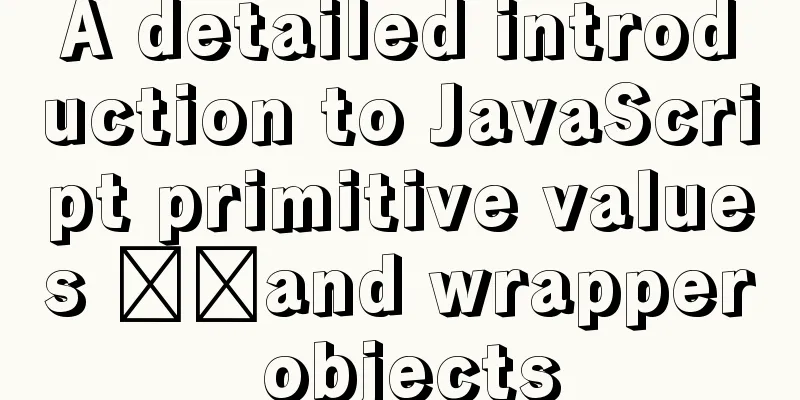A detailed introduction to JavaScript primitive values and wrapper objects

PrefaceAs JavaScript becomes more and more popular, more and more developers are beginning to get in touch with and use JavaScript. At the same time, I also found that many developers do not have a clear understanding of the most basic primitive values and package objects in JavaScript. So in this article, Zhapi will introduce them to you in detail. 🧐 Without further ado, let’s go! text Primitive typesPrimitive types are also called "base types". There are currently the following primitive types in JavaScript:
📝 As follows: typeof 'chenpipi'; // "string" typeof 12345; // "number" typeof true; // "boolean" typeof null; // "object" typeof undefined; // "undefined" typeof 12345n; // "bigint" typeof Symbol(); // "symbol" 💡 Special attention
Primitive valuesPrimitive values are values (data) of primitive types. A primitive value is data that is not an object and has no methods. A primitive value is a non-object data that does not have any methods. That is to say, primitive values such as string, number and boolean do not have any properties or methods. 😨 At this time, have those friends with a keen sense of smell already noticed that something is wrong? It’s cumin! I added cumin! (Manually cross out the dog head) 🤓 There is a very interesting point here, but before discussing this issue, let us first understand the packaging object. Wrapper objectsAll primitive types except null and undefined have their corresponding wrapper objects:
ObjectObject is a reference type. First, the wrapper object itself is an object and also a function. String instanceof Object; // true String instanceof Function; // true ConstructorInstance String, Number, and Boolean all support the use of the new operator to create corresponding packaging object instances. 📝 For example, the declaration of String (excerpt):
interface StringConstructor {
new(value?: any): String;
(value?: any): string;
readonly prototype: String;
}
declare var String : StringConstructor;
📝 The data obtained using the new operator is an object:
// string typeof 'pp'; // "string"
typeof new String('pp'); // "object"
new String() instanceof Object; // true
// number typeof 123; // "number"
typeof new Number(123); // "object"
new Number() instanceof Object; // true
// Boolean typeof true; // "boolean"
typeof new Boolean(true); // "object"
new Boolean() instanceof Object; // true
📝 We can call the valueOf() function of the wrapped object instance to get its original value:
// String let s = new String('pp');
s.valueOf(); // "pp"
typeof s.valueOf(); // "string"
// Number let n = new Number(123);
n.valueOf(); // 123
typeof n.valueOf(); // "number"
// Boolean let b = new Boolean(true);
b.valueOf(); // true
typeof b.valueOf(); // "boolean"
“Outliers” (Attention) BigInt and Symbol are both "incomplete classes" and do not support the new operator. 📝 For example, the declaration of BigInt (excerpt):
interface BigIntConstructor {
(value?: any): bigint;
readonly prototype: BigInt;
}
declare var BigInt : BigIntConstructor;
You can see that there is no new operator related function in the BigInt declaration. Ordinary function (Function)Wrapper objects can also be used as normal functions. The String(), Number() and Boolean() functions can be used to perform explicit type conversion on any type of data. In addition, the Object() function can also be used for explicit type conversion, but this article will not expand on this. String 📝 Example code:
typeof String(); // "string"
String(); // ""
String('pp'); // "pp"
String(123); // "123"
String(true); // "true"
String(false); // "false"
String(null); // "null"
String(undefined); // "undefined"
String([]); // ""
String({}); // "[object Object]"
💡 Tip 1
💡 Tip 2
Number 📝 Example code:
typeof Number(); // "number"
Number(); // 0
Number(''); // 0
Number('pp'); // NaN
Number(123); // 123
Number(true); // 1
Number(false); // 0
Number(null); // 0
Number(undefined); // NaN
Number([]); // 0
Number({}); // NaN
💡 Tips
Boolean 📝 Example code:
typeof Boolean(); // "boolean"
Boolean(); // false
Boolean(''); // false
Boolean('pp'); // true
Boolean(0); // false
Boolean(1); // true
Boolean(null); // false
Boolean(undefined); // false
Boolean([]); // true
Boolean({}); // true
💡 Tips
BigInt The BigInt() function is used to convert an integer to a big integer. This function accepts an integer as a parameter. If the passed parameter is a floating point number or any non-numeric type data, an error will be reported. 📝 Example code: BigInt(123); // 123n BigInt(123n); // 123n typeof 123n; // "bigint" typeof BigInt(123); // "bigint" BigInt & Number It should be noted that BigInt and Number are not strictly equal (loosely equal). 📝 Example code: 123n === 123; // false 123n == 123; // true Symbol The Symbol() function is used to create a value of type symbol. This function accepts a string as a descriptor (parameter). If a value of another type is passed in, it will be converted to a string (except undefined). Note that each symbol value is unique, even if their descriptors are the same. And symbol type data can only be created through the Symbol() function. 📝 Example code:
// The return value below is simulated by Devtools, not the actual value Symbol('pp'); // Symbol(pp)
Symbol(123); // Symbol(123)
Symbol(null); // Symbol(null)
Symbol({}); // Symbol([object Object])
// typetypeof Symbol('pp'); // "symbol"
Symbol('pp') === Symbol('pp'); // false
// Descriptor Symbol('pp').description; // "pp"
Symbol(123).description; // "123"
Symbol({}).description; // "[object Object]"
Symbol().description; // undefined
Symbol(undefined).description; // undefined
Primitive not Object🎃 The interesting part is coming~ No properties, no functionsEarlier in this article, it was mentioned that “a primitive value is a non-object data that does not have any methods.” We all know that objects can have properties and methods. But strings are not objects, so you can't add properties to them. 📝 Do a little experiment: let a = 'chenpipi'; console.log(a.length); // 8 // Try to add a new attribute a.name = 'Danzu Wu'; console.log(a.name); // undefined // Try to modify an existing property typeof a.slice; // "function" a.slice = null; typeof a.slice; // "function" 🎬 Zhapi Small Theater At this time, a stubborn friend used the rebuttal skill. You jerk, stop fooling people here. When I usually write bugs or not code, I can obviously call methods on strings, numbers and Boolean values! 📝 For example, the following code can be executed normally and get the expected results: // string let s = 'chenpipi'; s.toUpperCase(); // "CHENPIPI" 'ChenPiPi'.slice(4); // "PiPi" // Number let n = 123; n.toString(); // "123" (123.45).toFixed(2); // "123.5" // Boolean value let b = true; b.toString(); // "true" false.toString(); // "false" 💡 Useless trivia
🤔 That's weird So since strings are not objects, why do strings have attributes and methods? On second thought, numbers are just numbers, how can there be any methods in numbers? This is indeed illogical, but it also contradicts reality. What's going on? ? ? Stand User (I can't translate this)The answer is revealed~ 😎 Operating in secret Take string as an example. When we read the properties or methods of a string in the code, JavaScript will silently perform the following operations:
📝 For example: let a = 'chenpipi'; console.log(a); // "chenpipi" // ------------------------------ let b1 = a.length; console.log(b1); // 8 // The above code is equivalent to: let b2 = (new String(a)).length; console.log(b2); // 8 // ------------------------------ let c1 = a.toUpperCase(); console.log(c1); // "CHENPIPI" // The above code is equivalent to: let c2 = (new String(a)).toUpperCase(); console.log(c2); // "CHENPIPI" The same goes for numbers and booleans, but numbers are created using new Number(), while booleans are created using new Boolean(). 📝 In addition to the above examples, the most powerful proof is their constructor: 'chenpipi'.constructor === String; // true (12345).constructor === Number; // true true.constructor === Boolean; // true All of this is done in the dark by JavaScript, and the temporary objects generated in the process are one-time (thrown away after use). 😮 I see Wuhu, now it makes sense! This also explains why we can access properties and methods on strings, but cannot add or modify properties. That's because the target we are actually operating on is the temporary object created by JavaScript, not the string itself! So our addition or modification operation is actually effective, but it is only effective on a temporary object! 📝 Like this: // In code: let a = 'chenpipi'; a.name = 'Daniel Wu'; console.log(a.name); // undefined // equivalent to: let a = 'chenpipi'; (new String(a)).name = 'Daniel Wu'; console.log(a.name); // undefined // equivalent to: let a = 'chenpipi'; let temp = new String(a); temp.name = 'Daniel Wu'; console.log(a.name); // undefined Summary🎉 The above is the full content of this article. Finally, let’s summarize:
We don't usually pay attention to this when we write code, and in fact it doesn't affect our writing of code. So, isn't this article a waste of time? 🙉 Yes, but not entirely~ Know yourself and know your enemy, and you will win every battle. After learning these useless little knowledge, you can have a deeper understanding of JavaScript. At least you can use it to brag (dog head~). Related Materials JavaScript Advanced Programming (4th Edition) JavaScript: The Definitive Guide (6th Edition) Primitive - MDN: https://developer.mozilla.org/en-US/docs/Glossary/Primitive The history of “typeof null”: https://2ality.com/2013/10/typeof-null.html This is the end of this article about JavaScript primitive values and wrapper objects. For more relevant JS primitive values and wrapper objects content, please search for previous articles on 123WORDPRESS.COM or continue to browse the following related articles. I hope everyone will support 123WORDPRESS.COM in the future! You may also be interested in:
|
<<: How to dynamically add ports to Docker without rebuilding the image
>>: MySQL 8.0.11 compressed version installation and configuration method graphic tutorial
Recommend
Solution to MySQL remote connection failure
I have encountered the problem that MySQL can con...
MySQL uses triggers to solve the row limit of the table in the database. Detailed explanation and examples
MySQL uses triggers to solve the row limit of the...
Canvas draws scratch card effect
This article shares the specific code for drawing...
The shortest JS to determine whether it is IE6 (IE writing method)
Commonly used JavaScript code to detect which ver...
Nginx access control and parameter tuning methods
Nginx global variables There are many global vari...
Two ways to write stored procedures in Mysql with and without return values
Process 1: with return value: drop procedure if e...
A brief analysis of the count tracking of a request in nginx
First, let me explain the application method. The...
Solution to invalid margin-top of elements in div tags
Just as the title says. The question is very stran...
Implementation code for adding links to FLASH through HTML (div layer)
Today a client wants to run an advertisement, and ...
The problem of Vue+tsx using slot is not replaced
Table of contents Preface Find the problem solve ...
How to remove the "Enter" in the form, "Submit" and "Enter != Submit"
To implement the "Enter != Submit" probl...
Vue3 Vue Event Handling Guide
Table of contents 1. Basic event handling 2. Send...
How to completely uninstall mysql under CentOS
This article records the complete uninstallation ...
Summary of five commands to check swap space in Linux
Preface Two types of swap space can be created un...
Detailed explanation of triangle drawing and clever application examples in CSS
lead Some common triangles on web pages can be dr...









